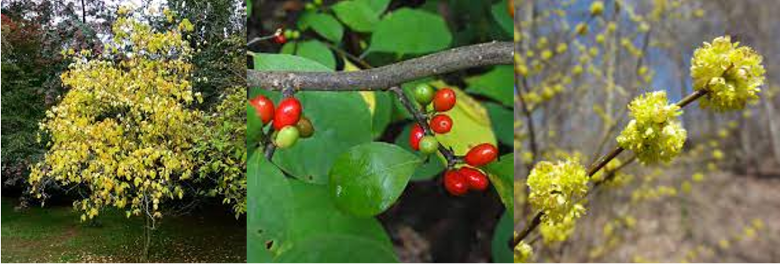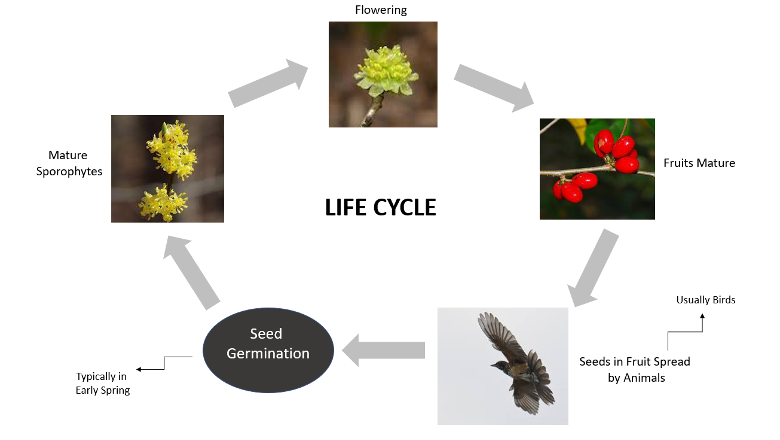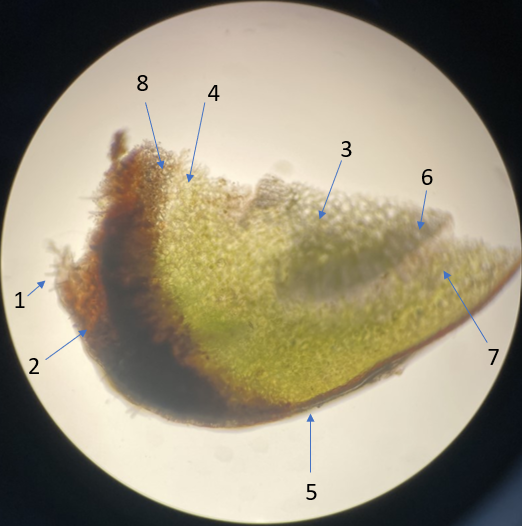1.4 Lindera Benzoin
Jessica Douglas
Lindera Benzoin
Author: Jessica Douglas
1. Plant Description
Lindera Benzoin is also known as the Northern Spicebush due to its spicy odour when its leaves are crushed (Kent, 2021). This plant grows throughout North America and in the Carolinian zone (Caldwell, 2019). This plant is a:
- Shrub: a small woody plant that has several main stems near the ground
- Perennial: persists every season of the year and lives for several years
- Dicotyledon: a flowering plant that contains 2 seed leaves
- Dioecious: have female and male flowers on separate plants
- Angiosperm: a seed plant that grows flowers, and in this case also grows fruit
- Deciduous: sheds its leaves annually
2. Identification
While walking through the Carolinian zone, you may come across the Lindera benzoin. It has some known features that will help identify it.
Fruit and Flowers: The flowers bloom in the spring, around March or April. Each flower has about 6 yellow or greenish-yellow sepals. These flowers are typically arranged in dense clusters. The fruit on this plant is glossy-red in colour (Lady Bird Johnson Wildflower Center, n.d.). The fruit and the leaves are aromatic, giving off a spicy fragrance (Lady Bird Johnson Wildflower Center, n.d.).
Leaves: The alternating leaves can be up to 15cm long and 6cm wide (Lady Bird Johnson Wildflower Center, n.d.). Leaves are entire, meaning they have smooth edges. The leaves are also obovate, which are egg-shaped with a wider portion away from the stem (Kent, 2021). The upper surface of the leaf is dark green, while the lower surface of the leaf is a lighter green in colour (Lady Bird Johnson Wildflower Center, n.d.). The leaves then turn a golden yellow colour during the fall (Lady Bird Johnson Wildflower Center, n.d.).
Bark: This shrub has thin bark, usually brown or grey-brown in colour and smooth (Kent, 2021). The bark is full of lenticels that look like a raised white area used for gas exchange (Awesome Native Plants, n.d.).
Habitat: These plants typically live in low, deciduous woods and wetlands (Lady Bird Johnson Wildflower Center, n.d.).

3. Cultivation
Soil: The soil moisture can be anywhere from dry to moist to wet (Izel Native Plants, n.d.). It is able to grow in rich or average soil made of sand or loam (Izel Native Plants, n.d.). The ideal pH of the soil would be 4.5-6 (Plants for a Future, n.d.).
Sunlight: It can grow in full sun, part sun, or part shade (Izel Native Plants, n.d.).
Locations: The plant does best when grown in wetlands.
Seed Germination: The seed has a short life span for when it will be successful and should not be allowed to dry out (Plants for a Future, n.d.). The seeds should be placed in individual pots and grown in a greenhouse for the first winter (Plants for a Future, n.d.). They may root by the spring, and then in the late spring/early summer the seeds can be planted outside (Plants for a Future, n.d.).
4. Cultural History
Teas can be made from the Lindera benzoin’s bark, twigs, and berries. In the past, the teas were used as medicine to treat diseases and other conditions. American Indians made tea from the bark and used it as a “blood purifier” to treat sweating, colds, rheumatism, and anemia, while settlers used bark tea to expel worms and treat typhoid fevers (Malone-Brown, n.d.). The settlers also made tea from the twigs of the Lindera benzoin to treat conditions such as colds, fevers, worms, and gas (Malone-Brown, n.d.). Indigenous peoples used tea made from the berries to treat measles, coughs, cramps, and delayed menstrual cycles, and settlers used it to prevent gas and flatulence (Malone-Brown, n.d.).
Other parts of the Lindera Benzoin were considered useful without being made into tea. The fruit oil was believed to be medicinal as it was extracted and used to treat chronic rheumatism, bruises, muscles, and joints (Malone-Brown, n.d.). Also, the plant leaves contain the chemical camphor, which was used as an insect repellent (Malone-Brown, n.d.).
5. Life Cycle

Flowering: Dense clusters of tiny, light yellow flowers bloom in early spring. Male plants have flowers that are larger and showier than female plants do (Missouri Botanical Garden, n.d.). The female plants contain pistillate flowers, and the male plants contain staminate flowers (Awesome Native Plants, n.d.). These male flowers have a rudimentary pistil and 9 stamens (Awesome Native Plants, n.d.). The inner 3 stamens contain nectar glands at their base, which are used to pollinate female plants (Awesome Native Plants, n.d.).

Fruits Mature: Female plants produce glossy red berries, often during the fall and after pollination from a male plant. Each of these fruits holds a single brown seed. The fruit is oblong drupes, meaning they are oval-shaped fleshy fruit with hard endocarp surrounding the seeds (Kent, 2021). The timing of the fruit is important because most of the fruit’s seeds are spread by birds, and therefore, it has to coincide with bird migration.
Seeds Spread by Animals: As mentioned above, animals (mostly birds) will eat the fruits from the female plants. The fruits contain seeds that are then dispersed as the animals digest the fruit and release the seeds elsewhere.
Seed Germination: Seed germination refers to the sprouting of a seed. The seed sprouting relies on water absorption, temperature, oxygen availability, light exposure, and other factors. The seeds will wait until the environment is ideal before participating in this sprouting. A large amount of the seeds will be germinated in the first spring; however, some won’t be germinated until the following spring (Plants for a Future, n.d.).
Mature Sporophytes: After the seed germinates, it grows into a young sporophyte and then into a mature sporophyte. In the female plant, the mature sporophyte contains an ovary with an ovule inside. Inside the ovule is the megaspore mother cell, which goes through the process of meiosis to produce an egg. In the male plant, the mature sporophyte contains an anther with the microspore mother cell inside. The microspore mother cell undergoes mitosis to produce pollen, which will pollinate the female plant.
6. Anatomy and Physiology
Anatomy of the Stem and Leaf
Phloem and xylem are the vascular cells in the plant, also known as conducting cells. The phloem conducts food such as carbon, and the xylem conducts water, dissolved minerals, and inorganic ions. The epidermis is a layer of specialized cells that cover the outermost layer of the stem/leaf. The cortex is the layer of cells that lie between the epidermis and the vascular cells, which store carbohydrates and other essential substances. The pith cells store water and also produce sugar and ethanol. The cuticle on the outer edge of the stem is responsible for controlling the amount of water that enters and exits the cell. Shoot hairs, also known as trichomes, help to prevent water loss from the stem surface. The collenchyma provides structural support to the plant organs.


Light Availability
A plant’s fitness refers to its ability to survive and reproduce. The fitness of the Lindera benzoin relies mainly on light availability. Higher light availability is connected to increased photosynthesis and higher carbon gain, which increases the rate of reproduction (Niesenbaum, 1993). Plants that have less carbon resources have a higher abortion rate than seeds and fruit (Niesenbaum, 1993). It is often the light availability from the previous season that affects the reproduction of the current season (Niesenbaum, 1993). Low light availability from the previous season also results in less flower production per fruit-bearing branch (Niesenbaum, 1993). Fewer flowers per branch would also mean fewer fruits being produced per branch. The fruit contains the seeds that are needed for seed germination and for new plants to be produced. Therefore, lower light availability causes a decrease in reproduction.
Elevated CO2
As mentioned above, carbon is gained through the process of photosynthesis and increases the rate of reproduction. Therefore, when CO2 levels are elevated, it was thought that plant growth would be increased. However, when Lindera benzoin is exposed to increased CO2 levels, stem and leaf growth do not increase (Cipollini et al., 1993). Instead, the extra carbon is stored or used for underground growth (Cipollini et al., 1993).
Secondary Metabolites
Herbivory is when animals and insects eat plants. Lindera benzoin plants experience more herbivory when they are mostly shaded than when they are mostly in sunlight (Ingersoll et al., 2010). This is due to the production of secondary metabolites in the plants in the sun, such as phenolic compounds, which are known to have plant defence mechanisms (Ingersoll et al., 2010). The total concentration of phenolic compounds is found to be higher in plants in the sun than in plants in the shade (Ingersoll et al., 2010). These phenolic compounds are toxic to animals and act as pesticides against insects, decreasing the amount of herbivory experienced (Ingersoll et al., 2010).
Phenolic compounds also act as a defence against pathogens, such as bacteria and fungi, and against environmental stress, such as drought, UV, and salinity (Kumar et al., 2020). These compounds contain antimicrobial and antioxidant characteristics that fight against infections and protect tissues from oxidative stress. There is a rapid upregulation of the genes of these phenolic compounds as a result of environmental stresses (Kumar et al., 2020). Phenolic compounds have different structures containing a number amounts of carbons, which indicate the function of the compound and what it fights against (Kumar et al., 2020).
7. Summary
Lindera benzoin is beautiful to see in the spring and summer when its flowers are in bloom and its glossy-red berries growing in the fall. Ontario is lucky to have to have these plants growing throughout the Carolinian zone.
References
Awesome Native Plants. (n.d.). Lindera Benzoin – Spicebush. https://awesomenativeplants.info/photo_galleries/photo_pages/lindera_benzoin.html
Caldwell, C. (2019). Spicebush (lindera benzoin). Piedmont Master Gardeners. https://piedmontmastergardeners.org/article/spicebush-lindera-benzoin/
Cipollini, M. L., Drake, B. G., & Whigham, D. (1993). Effects of elevated CO2 on growth and carbon/nutrient balance in the deciduous woody shrub Lindera benzoin (L.) Blume (Lauraceae). Oecologia, 96(3), 339–346. https://www.doi.org/10.1007/bf00317503
Ingersoll, C. M., Niesenbaum, R. A., Weigle, C. E., & Lehman, J. H. (2010). Total phenolics and individual phenolic acids vary with light environment in lindera benzoin. Botany, 88(11), 1007–1010. https://www.doi.org/10.1139/b10-072
Izel Native Plants. (n.d.). Lindera Benzoin – northern spicebush. https://www.izelplants.com/lindera-benzoin-northern-spicebush/
Kent, T. H. (2021, October 7). Lindera benzoin (L.) Blume. FloraFinder.org. https://florafinder.org/Species/Lindera_benzoin.php
Kumar, S., Abedin, Md. M., Singh, A. K., & Das, S. (2020). Role of phenolic compounds in plant-defensive mechanisms. Plant Phenolics in Sustainable Agriculture, 517–532. https://www.doi.org/10.1007/978-981-15-4890-1_22
Lady Bird Johnson Wildflower Center. (n.d.). Plant database: Lindera Benzoin. University of Texas at Austin. Retrieved from https://www.wildflower.org/plants/result.php?id_plant=libe3
Malone-Brown, E. (2009). Lindera Benzoin (spicebush). The Jefferson Monticello. https://www.monticello.org/sites/library/exhibits/lucymarks/gallery/spicebush.html#:~:text=Medicinal%20Uses%3A,a%20diaphoretic%20for%20other%20fevers
Missouri Botanical Garden. (n.d.). Lindera Benzoin. https://www.missouribotanicalgarden.org/PlantFinder/PlantFinderDetails.aspx?kempercode=d890#:~:text=Lindera%20benzoin%2C%20commonly%20called%20spicebush,ravines%2C%20valleys%20and%20along%20streams
Niesenbaum, R. A. (1993). Light or pollen–seasonal limitations on female reproductive success in the understory shrub Lindera benzoin. The Journal of Ecology, 81(2), 315. https://www.doi.org/10.2307/2261501
Plants for a Future. (n.d.). Lindera Benzoin – (L.)Blume. Plants for a Future. https://pfaf.org/user/Plant.aspx?LatinName=Lindera%2Bbenzoin


